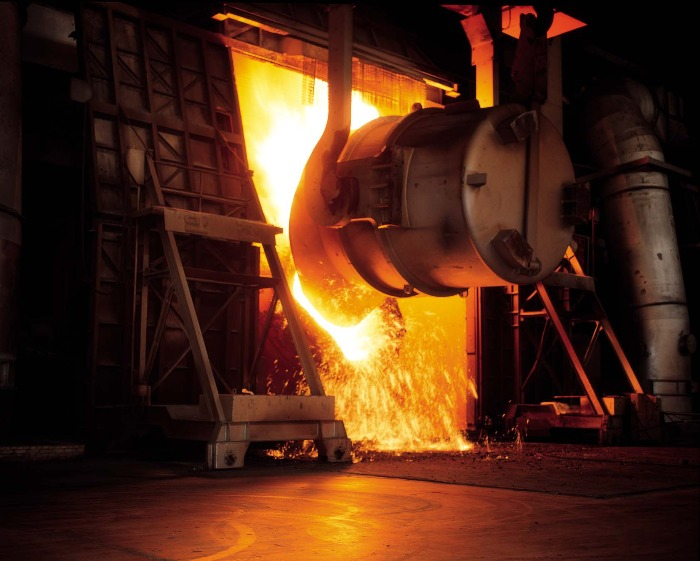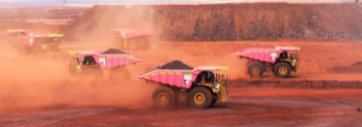Carbon neutrality
POSCO to build mini mills for carbon neutrality
Seeks joint investment to set up HBI production facility with an annual capacity of 2 million tons in Australia
By Dec 20, 2021 (Gmt+09:00)
5
Min read
Most Read
LG Chem to sell water filter business to Glenwood PE for $692 million


Kyobo Life poised to buy Japan’s SBI Group-owned savings bank


KT&G eyes overseas M&A after rejecting activist fund's offer


StockX in merger talks with Naver’s online reseller Kream


Mirae Asset to be named Korea Post’s core real estate fund operator



POSCO Co., the world’s No. 5 steelmaker, plans to build mini mills, electric arc furnaces for hot rolled steel, in South Korea as part of its quest for carbon neutrality. The domestic steel industry had abandoned mini mills in the mid-2010s due to high costs and low productivity.
South Korea’s top steel producer is set to use hot briquetted iron (HBI) for the mini mills, shaking up the raw materials market now dominated by iron ore and scrap.
POSCO plans to construct two mini mills by 2027 that are expected to have an annual capacity of 800,000 tons-1 million tons each, according to industry sources on Dec. 20.
They are slated to replace the country’s oldest blast furnace with a capacity of 1.3 million tons a year. The blast furnace started operation in 1973.
POSCO plans to use HBI, pure iron that is extracted from iron ore using natural gas, as raw materials, instead of scrap, to produce high-quality steel sheets. That compares with other electric arc furnaces that use scrap to roll out products such as steel bars.
The move came on surging prices of scrap that global steelmakers have been scrambling for to cut carbon emissions. Scrap prices topped 600,000 won ($503.5) per ton to their highest point since 2008 as the industry increased the use of scrap for steel production.
Industry sources remain doubtful if POSCO can overcome mini mills’ inherent issues of high costs and low quality.
“The industry has secured technology for quality to some degree, but costs are a key problem,” said a steel industry source. “But more and more customers are paying high costs for eco-friendly steel products and we are unlikely to suffer the same problems as in the past.”
ELECTRIC ARC FURNACES FOR CARBON REDUCTION
South Korea’s steel industry introduced mini mills in the 1990s to reduce reliance on blast furnaces and cut carbon emissions. The local sector, however, stopped using them due to mounting losses on high power bills and low productivity. POSCO in 2015 turned off its mini mill plant that started operations in 1996.
The mini mill, however, has been revived as pressure on the world’s steel industry has grown to reduce carbon emissions. An electric arc furnace emits about a quarter of the carbon of a blast furnace to produce steel. Global steelmakers aim to eventually use only electric arc furnaces, abandoning all blast furnaces, to achieve their goals of carbon neutrality.
US Steel in September announced that it has begun looking for a site in the US to build a mini mill to produce 3 million tons a year at an estimated cost of $3 billion. Japan’s Nippon Steel Corp. also started basic works to start operations of a mini mill with an annual capacity of 15 million tons in 2023.
HBI FACILITY IN AUSTRALIA
The change rocked the global steel raw materials market that has been dominated by iron ore and scrap as the move caused the industry to focus on HBI, which is manufactured mostly in the Middle East and North Africa, major production areas of natural gas.
“HBI needs a separate supply chain from iron ore and scrap that has large distribution markets,” said another industry source. “The cost function for steel production is changing.”
POSCO started setting up a supply chain for HBI to be used in the planned mini mills. The South Korean steelmaker is seeking joint investment for an HBI production facility with an annual capacity of 2 million tons in collaboration with an Australian iron ore mine, according to industry sources. The country’s Roy Hill mine, in which POSCO has a 12.5% stake, is considered a strong candidate for the site.

Most HBI production facilities are located in natural gas-rich regions such as the Middle East and North Africa that help HBI producers improve price competitiveness by cutting costs of natural gas transportation that is usually expensive. Australia is a major natural gas producer.
“We must have a production base that has easy access to iron ore and natural gas with consideration of costs for transportation to steel mills,” said the other industry source.
GLOBAL MOVES TO CUT CARBON EMISSIONS
The global steel industry has been accelerating steps to reduce carbon emissions with a target of hydrogen-based steel production. The hydrogen-based steelmaking process uses green hydrogen instead of coal as a reducing agent to separate oxygen from iron ore, to produce no carbon emissions.
Steelmakers raised scrap uses for blast furnaces to cut coal consumption while converting blast furnaces to electric arc furnaces. The move is, however, expected to raise product prices.
China Baowu Steel Group, the world’s No. 1 steel producer, aims to slash its emissions 30% by 2035 as part of its goal to be carbon neutral by 2050, a decade earlier than the government’s goal. The steelmaker planned to increase scrap use for blast furnaces to 50% from 10% while replacing the facilities with electronic arc furnaces.
ArcelorMittal SA, the world’s second-largest player with steel mills in Europe, Asia and North America, was set to focus on direct reduced iron (DRI) plants that will use green hydrogen to reduce iron ore in a carbon dioxide-free steelmaking process. The company announced a $100 billion plan to replace the existing blast furnaces with the DRI plants by 2030.
Nippon Steel unveiled a plan to reduce the number of blast furnaces in Japan to 10 from 15 and replace them with new electric arc furnaces to be built at home and abroad. The measure is predicted to slash Japan’s total steel capacity by 20%, or 10 million tons a year. In December 2020, Nippon Steel also announced a plan to construct such a facility with ArcelorMittal at their US joint venture in Alabama.
But the sector’s ambitious plans for carbon neutrality do not come cheap, industry sources warned.
Baowu expected prices of hot-rolled coil in China to jump 40% due to higher costs for eco-friendly steel production.
“Power for electric arc furnaces is expensive since it is produced with eco-friendly energy,” said a steel industry source. “Steel product prices will inevitably surge from 2024 when electric arc furnaces currently under construction begin replacing blast furnaces.”
Write to Jung-hwan Hwang at jung@hankyung.com
Jongwoo Cheon edited this article.
More to Read
-
 Scrap metal scarcitySteel scrap in high demand in steelmakers' push to cut emissions
Scrap metal scarcitySteel scrap in high demand in steelmakers' push to cut emissionsNov 07, 2021 (Gmt+09:00)
3 Min read -

-

-
 Carbon neutralityPOSCO partners with Australia’s Roy Hill for carbon neutrality initiatives
Carbon neutralityPOSCO partners with Australia’s Roy Hill for carbon neutrality initiativesAug 02, 2021 (Gmt+09:00)
2 Min read -
 Hydrogen economyKorea forms ambitious public-private green ammonia alliance
Hydrogen economyKorea forms ambitious public-private green ammonia allianceJul 16, 2021 (Gmt+09:00)
3 Min read -
 ESGSK Chairman vows to achieve carbon neutrality ahead of 2050 UN target
ESGSK Chairman vows to achieve carbon neutrality ahead of 2050 UN targetJun 23, 2021 (Gmt+09:00)
3 Min read -
 Carbon neutralityHyundai Motor chairman vows to go carbon neutral, stresses electrification
Carbon neutralityHyundai Motor chairman vows to go carbon neutral, stresses electrificationMay 25, 2021 (Gmt+09:00)
2 Min read
Comment 0
LOG IN


